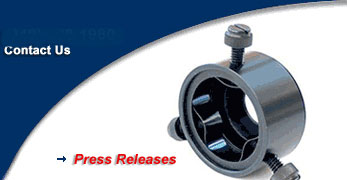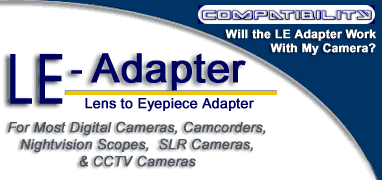|
"Bobs Experiment"
The following article was recently submitted to Lens Adapter.net by Bob Armstrong a well known professional "Digiscoping" photographer residing in Alaska. The article discusses Bob’s introduction to iPhoneography with an Apple iPhone 4S and iTouch camera attached to the eyeppiece of a Kowa Spotting Scope as well as to a 2 inch eyepiece Leica Spotting Scope with the IPhone LE-Adapter Sleeve.
* See PHOTOGRAPHING NATURE IN ALASKA BY ROBERT H. ARMSTRONG
|
I have experimented with the LE-Adapter and sleeve for use with the iPhone 4S and iTouch cameras when attached to a spotting scope. My conclusions are:
1. This is a great set-up for birders which often use spotting scopes and usually have an iPhone or iTouch with them complete with bird identification apps. With this set-up you can document what you saw and easily share it with others (sometimes right on the spot via e-mail).
2. This set-up makes it easy to share visually with others in the field what you are looking at. The nice bright and fairly large screens of the iPhone and iTouch can be seen much better than the cameras I have used for digiscoping. others in the field what you are looking at. The nice bright and fairly large screens of the iPhone and iTouch can be seen much better than the cameras I have used for digiscoping.
3. It makes it easier to take videos from a distance without disturbing your subject. You can import the video into photoshop and capture special images. Here is an example of an image captured of a Bonaparte's gull in flight over a stream. photoshop and capture special images. Here is an example of an image captured of a Bonaparte's gull in flight over a stream.
4. In general the camera used with the iPhone 4S gives images that are just fine for e-mailing, use in power point presentations and under certain conditions for publication. At 300 dots per inch it gives and image of 10.88 inches by 8.16 inches which is fine for most publications. If there are white areas in the subject I noticed it was difficult to get rid of the burned out areas. Perhaps with more experimentation or certain camera apps this can be avoided.
5. With the iTouch camera it gave an image ok for e-mailing or power point presentation. At 300 dots per inch the images were 2.4 inches by 1.8 inches too small for most publications.
|
I did one experiment under very difficult conditions. It was rainy and windy and an eagle appeared as a dot in the distance -- well over 100-200 yards away. I was very impressed with the results at 40 power on the scope (presented in the two photos below without any cropping).
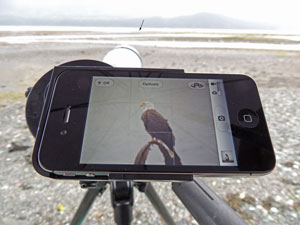
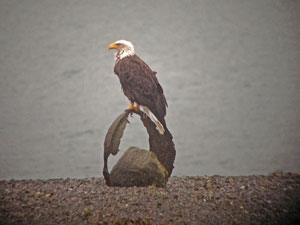
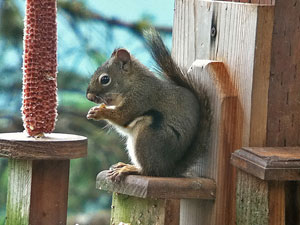
This photo was taken with an iTouch on a spotting scope.
Bob Armstrong *(naturebob.com)
|
Andy Bright from
the U.K. recently took the 2Plus LE-Adapter out in the
field for evaluation. He is using a Nikon 990 Digital
Camera coupled to a Swarovski Spotting Scope.
Subject: 2Plus LE-Adapter
Field Test Report
“I used the (2Plus)
LE-Adapter during a birding trip on Saturday morning. I
was struck by how easy and quickly it was to attach to the
scope…despite the 3 screws to tighten… the large size of
the screw heads meant they they were easy to grip. Though
the camera and adapter are quite bulky, it fits into a
small camera bag with ease…so it’s no big problem to get
the camera/adapter out and onto the scope’s eyepiece when
a photo opportunity arises. I was happy with the secure
attachment of camera/adapter to the scope and was
confident to walk around with the complete set-up on my
tripod without fear of any accidents (always make sure
that the scope is not pointing at the sun…otherwise a
fried ccd!). A Reed Bunting, Emberiza schoeniclus (6inches
– 15cm) taken at about 30 yards from the bird. You have
permission to use the pic on the web in relation to the
LE-Adapter.”
Best regards, Andy
My
Digiscoped U.K. Birds Website
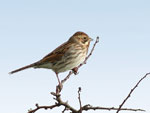
Kenneth Farmer, PhD, author of the “Extreme Camcorder
Handbook” has recently completed a product
review of our new 2Plus LE-Adapter. He stated “The
2Plus LE-Adapter opens up a host of new possibilities for
the camcorder and digital camera enthusiast who wants to
capture extreme long distance images using their favorite
telescope, spotting scope or even binoculars. The 2Plus
has the look and feel of a high quality optical accessory
right out of the box.”
Click HERE to
see images captured at a distance of 2 miles!!!!!
CSU Stanislaus
Botany Image Collection
Steve Wolf - CSU Stanislaus
(Steve's website
contains images taken with the LE-Adapter)
 I
use a
Nikon 990 digital camera and trinocular compound and
dissecting scopes with wide field eyepieces. The camera is
attached to the scope via a LE-Adapter available at
http://www.lensadapter.net
. If you don't have a
trinocular you can just mount the camera on one of the
eyepieces. Below is a photo of the set up I use. I find it
much easier to work via a TV monitor. I use the video out
from the camera into a TV with an RCA jack. This way you
see everything that appears on the camera LCD. I also
recommend using the AC adapter, otherwise you run through
batteries very quickly and the LCD times out. You must
use the Nikon remote to eliminate camera shake. You can't
use the self timer because that only works in macro mode.
I shoot in the infinity mode and focus via the microscope.
You do not want the camera to try to focus because it
rarely gets it right. I mostly use the program mode (A-REC).
Vignetting is a common problem. I
use a
Nikon 990 digital camera and trinocular compound and
dissecting scopes with wide field eyepieces. The camera is
attached to the scope via a LE-Adapter available at
http://www.lensadapter.net
. If you don't have a
trinocular you can just mount the camera on one of the
eyepieces. Below is a photo of the set up I use. I find it
much easier to work via a TV monitor. I use the video out
from the camera into a TV with an RCA jack. This way you
see everything that appears on the camera LCD. I also
recommend using the AC adapter, otherwise you run through
batteries very quickly and the LCD times out. You must
use the Nikon remote to eliminate camera shake. You can't
use the self timer because that only works in macro mode.
I shoot in the infinity mode and focus via the microscope.
You do not want the camera to try to focus because it
rarely gets it right. I mostly use the program mode (A-REC).
Vignetting is a common problem.
You can reduce it in two
ways: 1. use the optical zoom 2. use a relatively large
aperture (small f-stop). Take several photos of each slide
and slightly vary the microscope focus each time. This is
one of the main advantages of a digital camera, not having
to pay for film and developing! For "web publishing" I
take the photos at 1024 x 768 and crop them to 800 x 600.
I save in jpeg format with medium compression. Microscope
lamps vary considerably and the color temperature changes
depending on how high you turn up the lamp. Play with the
white balance and light levels. Once you find the most
accurate stick with those settings.
 Mav
Magazine has reviewed the LE-Adapter. See
what they have to say. URL -
http://www.mav-magazine.com/Jun1999/LE-Adapter/index.htm
Mav
Magazine has reviewed the LE-Adapter. See
what they have to say. URL -
http://www.mav-magazine.com/Jun1999/LE-Adapter/index.htm
 Robert
Shull, Director of Veterinary Medical Education
at the University of Tennessee recently sent some photos
he has taken with the Casio QV 8000 coupled to a
microscope. The Mast cell and Blastomyces yeast pictures
are taken at 800x!!!! Click Here to view some incredible
microscopic images.
Robert
Shull, Director of Veterinary Medical Education
at the University of Tennessee recently sent some photos
he has taken with the Casio QV 8000 coupled to a
microscope. The Mast cell and Blastomyces yeast pictures
are taken at 800x!!!! Click Here to view some incredible
microscopic images.
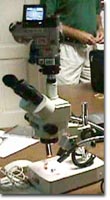  University
of Florida University
of Florida
Researchers,
extension agents and software developers with UF's
Institute of Food and Agricultural Sciences developed the
Distance Diagnostics and Identification System, or DDIS,
to speed up identification of plant and animal
physiological disorders.
Photo
(Right) is Mavica FD-91 coupled to microscope using the
LE-Adapter.
 Photo ( Left) Fungal
Body
Photo ( Left) Fungal
Body
from a Mildew Spore
 E-Adapter
Review by Michael Oates E-Adapter
Review by Michael Oates
Michael
Oates, a well known Amateur Astronomer, has recently
completed a evaluation of the LE-Adapter coupled to his
Mavica FD-91. Click HERE to view his recommendation and
lunar landscapes. URL - http://www.ph.u-net.com/mavica/le-adapter/
"Your
LE-Adapter has been an invaluable addition
to my surveillance equipment"
Fred Waters Investigations


The
following is a partial list of companies/institutions
who
have purchased the LE-Adapter:
Sony
Corp.
University
of Florida
3M Company
Advantage Investigations
LA Co.
Office of Education
Worcester Polytechnic Ins.
FBI
Friday
Architects/Planners
AFJ Investigations
Texas
A&M Univ.
Wake Forest University
Oceanic
Institute
Phoenix Investigations
Kennedy
Middle School
Avotec Inc
Fox Chase Cancer
Center
Washington State University
Purdue University
Ministry of Health, Ontario
Texas A&M University
U.S. Geologic Survey
Boston University School of Medicine |
Bausch
& Lomb
University
of Washington
Intel Corp.
Chambers
Investigations
Tufts University
Roche
Diagnostics
American Embassy, Belgium
University of
Illinois
St. Lawrence University
Montana
University
University of Georgia
National
Institute of Health
Virginia Tech
Sciscope
Instrument Co.
U.S. Army
Western Industrial
Tooling
University of Minnesota
Yale University
Bushnell Sports Optics
Carl Zeiss, Inc.
U.S. Border Patrol
Marine Science Institute |
|
